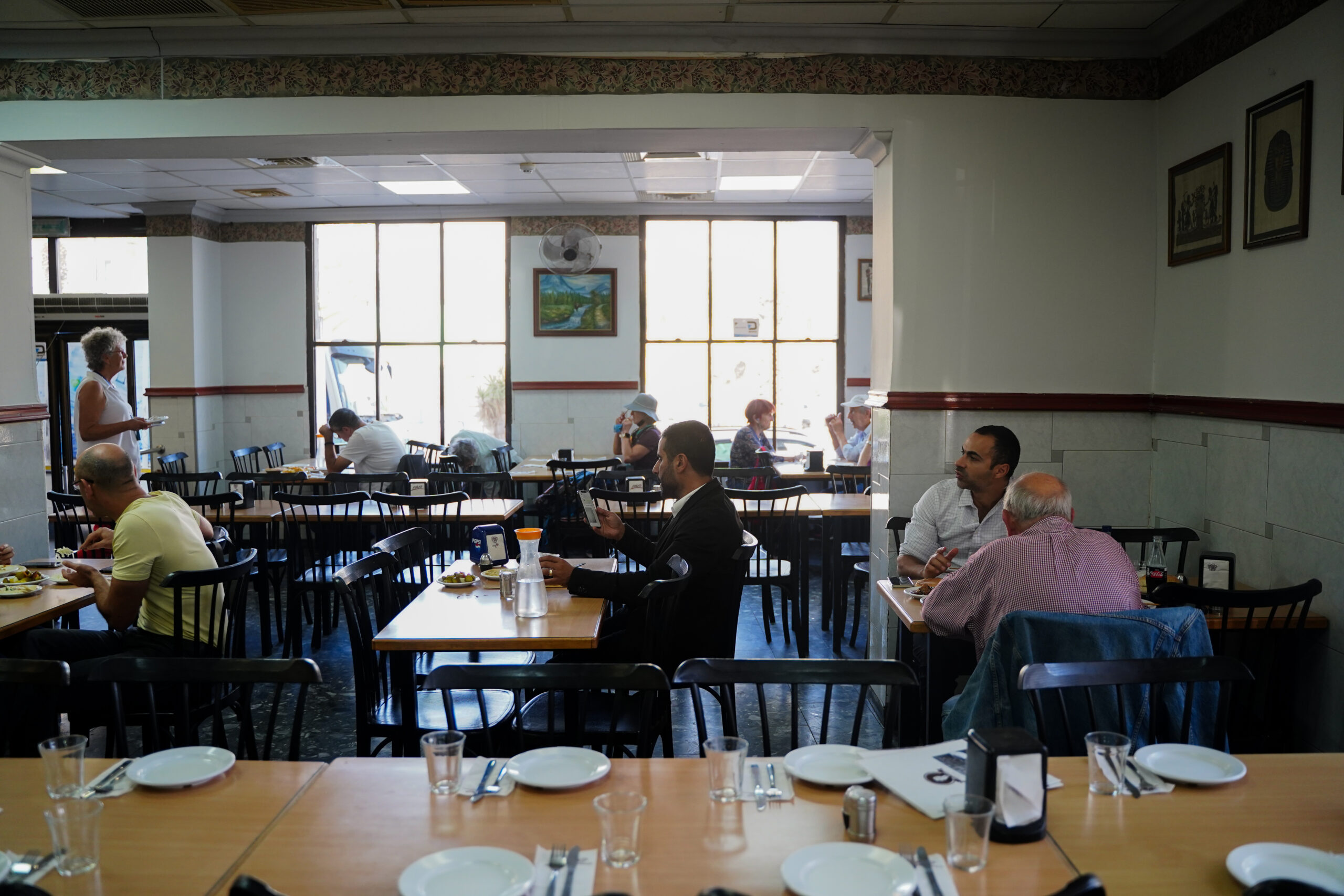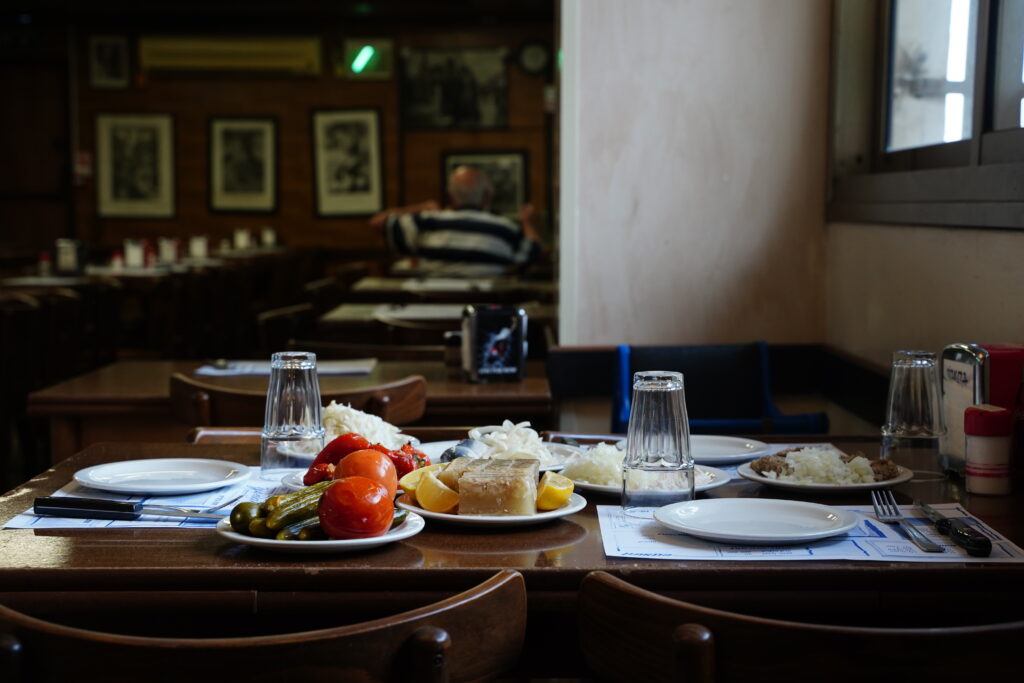
Asif’s exhibition space aims to promote local culinary discourse through collaborations between the culinary industry, artists, artisans, and researchers from various fields. The rotating exhibitions explore the relationship between food and history, anthropology, botany, agriculture, art, and more.
The current exhibition, “Home Away From Home Home Away From Home: A Tribute to Workers’ Restaurants” (curators: Liora Rosin and Rona Zinger), examines this disappearing institution and investigates the myths surrounding it. Through this, we examine social and cultural transformations in Israeli society.
Home Away From Home Away From Home: A Tribute to Workers' Restaurants
In an industrial zone brimming with auto repair shops and small factories, stands a little restaurant. Local workers come here to have lunch, fill their stomach, and rest a little before returning to their work.
Behind a central counter there are pots and steaming trays of food. The dishes are generously ladled into shallow bowls, and served with thick slices of bread to mop up any remaining gravy. A fixed menu hangs above the food display and any necessary changes are made by hand. When the pots are empty, the day ends, and the restaurant closes. Ceramic tiles cover the restaurant’s walls up to one’s hip to make them easier to clean. And, in a prominent place above, photographs of famous diners hang as proof of quality and success, alongside newspaper articles, greetings, certificates, a hamsa, a clock and a fan. On the formica-covered tables there’s a dispenser of flimsy napkins with the inscription “Bon Appetit” next to salt and pepper shakers. The staff are members of the same family, or seem to be; they cook, serve, chat with the customers and prepare the bill. The clientele is made up of regulars, the atmosphere is bustling and familiar, and everyone has one common goal: that the customers leave full and satisfied.
This is probably how we imagine a typical workers’ restaurant: the symbols, characteristics, language, and human dynamics appear almost instantly in our mind. Imaginary aromas fill our noses, and our mouth waters in expectation.
Yet history shows the restaurants destined to feed the Hebrew worker did not always look this way.
The cooperative restaurants of the 1920s and 1930s fed masses of people and their goal, like that of the dining rooms of the kibbutzim, was to ensure the Jewish halutzim (pioneers) had a hearty lunch. They served simple food at humble prices — fried eggs, sour cream, salad, and sometimes glasses of “tzuf,” a date drink, for dessert. Workers used their food stamps to pay for the meals.
Most workers were immigrants coming from a variety of countries. The simple food nourished their body and soul. The spaces stood in for their home kitchens, which they were away from during the work day, and perhaps also reminded them of the home countries they left when they immigrated.
Looking at today’s workers’ restaurants, it seems clear their customers are no longer “workers.” They have been replaced by upper-middle class diners, who come for an “authentic” experience with a spoonful of nostalgia.
The image of the workers has changed over time: most are no longer Jewish; instead, they are migrant workers and asylum seekers who usually spend their lunch break in the construction site or in the field.
The dishes themselves have changed, too; yet all their different variations hold a connection to the dishes workers ate a couple of generations ago. The food remains simple, so that workers can afford it; filling, to give them energy to return to their hard labor; and comforting, to provide a home away from home.
Curators’ Text, Liora Rosin and Rona Zinger
The Reincarnation of Workers’ Restaurants
From the establishment of the cooperative restaurants that fed early Zionists to the dining rooms of Google and restaurants next to Tel Aviv’s Central Bus Station popular with migrant workers and asylum seekers, workers’ restaurants in Israel have gone through many transformations. Professor Nir Avieli examines them in this compelling article.
Creator Nadav Harel
What Is a Worker's Restaurant in Israel?
We asked chefs, researchers, and professionals from across the culinary field such as chefs Haim Cohen, Avivit Priel and Nashat Abbas, food writer Amit Aharonson, and more, this question. We received an array of answers that touch on memories, and stories that are an integral part of the local food culture.
preserves (Restaurant Roaming)
Oilcloth-covered tables, uniform chairs, a salt and paper shaker (rice mixed in with the salt), and a dispenser of napkins proclaiming “Bon Appetit” with a great sense of dignity. What are the spatial characteristics of a workers’ restaurants? What makes a restaurant into a workers’ restaurant? Do these restaurants still exist today?
In an attempt to answer this question and identify their design and architectural characteristics, a journey between workers’ restaurants led to personal encounters and stories about food, family, culture and homes.
This work of Lihi Berger is part of a visual and humanistic research, wishing to diversify the generalized approach to workers’ restaurants and invite that spectator to listen to their individual stories.
The Labor
The Israeli job market no longer relies on the “Hebrew” Jewish laborer: most blue-collar workers are now migrant workers, asylum seekers with no legal status and Palestinians. An examination of workers’ restaurants raises an almost unavoidable question about the status of local workers and their exclusion from the restaurants that were originally established to feed them.
And yet, eating is a necessity for all, even for those who cannot afford to take a long, relaxing break from their daily routine and sit down in a restaurant. A split-screen video work presents different work environments, meals, and culinary interactions of workers in Israel today – A work By Dan Perez and Ilya Marcus.
Click here to read more about workers’ meals.
Dan Perez and Ilya Marcus Assistant photographer: Yair Fridman Photography equipment: Glikson

